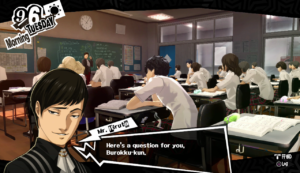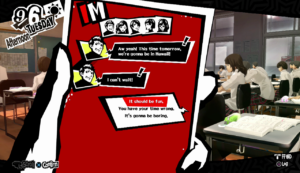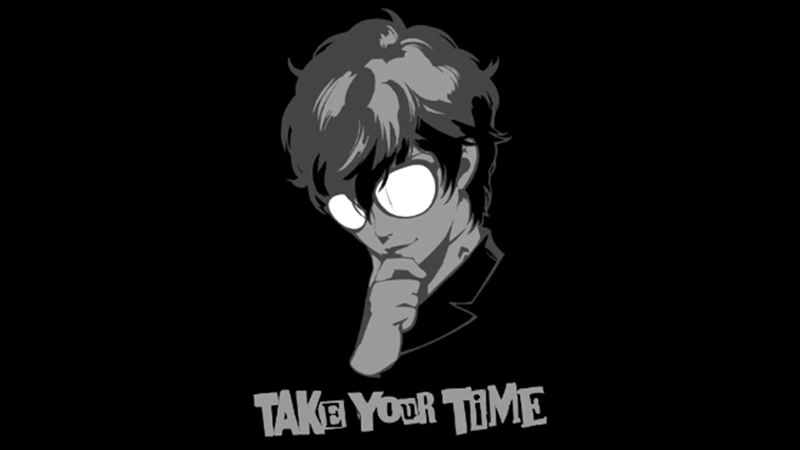For many North American gamers including myself, the Playstation & Playstation 2 generations were the golden eras of gaming thanks to the amount of experimentation and, most importantly, software from a bevy of developers & publishers that warranted any interested gamer in giving their product a chance. Atlus was no different, providing interesting role playing games featuring mature, adult-oriented themes seen through the eyes of teenagers rooted in the traditions of standard turn-based JRPGs mixed with “Pokemon” elements (if those pocket monsters were ready to rip an enemy’s throat out).
My first trying out the “Persona” series came in 2001 when I rented “Persona 2: Eternal Punishment”. Unfortunately, the offering was a little too much for my young mind to handle and the game’s greatness really went over my head. That problem faded away with each iteration in the series I played (including the official “Shin Megami Tensei” localized entries & the last two “Shin Megami Tensei: Persona” games released on the Playstation 2 including the barebones version of “Persona 4”). Not since 2009 have I fully experienced a “Persona” game due to my lack of owning a PS Vita or PS TV, so coming into “Persona 5” almost felt like a reintroduction to the franchise that really stood out in a once crowded genre for a variety of reasons that, hopefully, would become one of the most exciting games released in North America in 2017.
Did I Complete “Persona 5”?
It’s pretty much impossible to complete everything in a first playthrough (definitely impossible if one cares about optional content such as a boss battle solely attached to New Game Plus) and I came into my first playthrough with that knowledge; going out of my way to complete as many things as possible before the final dungeon. Upon saving my Clear Data specifically made for NG+, I had put in 113 hours into “Persona 5”. Rather than let the game sit for a while and come back to it in the future, I almost immediately started my New Game Plus playthrough with the intent of finishing off the trophies I didn’t attain such as maxing out all of the relationships and reading every book with my overpowered characters due to the ability to carry over all the equipment the player purchased. I fully expect to get another thirty to fifty hours out of “Persona 5”, not to mention reloading some of those saves before some important decisions to see the various endings I didn’t attain when trying to see the game’s best conclusion.
Did “Persona 5” Live Up to the Hype?
After being released in the fall of 2016 in its home country to high praise, anticipation for the worldwide release of “Persona 5” grew steadily thanks to the copious amounts of positive feedback it was getting from journalists & gamers alike. Atlus stuck to the franchise’s usual formula of placing the player in control of a mostly voiceless, nameable protagonist. Though the character can be named anything the player wants, he is known throughout a majority of the game by his codename “Joker”. Why “Joker”? Because he’s the “trickster” – an individual able to steal the hearts of people and help change the world. Essentially that is the basis of “Persona 5’s” story as an expanding group of teenagers dipping into the pool of prototypical anime archetypes including the student counsel president oblivious to the way her peers conduct themselves outside of school, a half-Japanese teen model whose exotic features in comparison to her classmates & teachers have garnered her negative attention, and even a talking cat (well, not really a “talking” feline, but one that only the main characters can understand) make up the cast.
Beyond the absurdity and stereotypical nature of these youngsters lies the real essence of the story: the land of Japan has become corrupted by the desires of adults using their money & power for their own benefit even if it means tearing down their home country in the process (though one character late in the game declares he wants to revitalize Japan, but how you can trust some snooty adult especially when he might be a ruthless criminal?). There’s really nothing unique about “Persona 5’s” story if someone has played previous games in the franchise, seen various anime with the same type of subject matter, or even read manga that has influenced many a memorable TV show & movie. The storytelling is where “Persona 5” shines thanks to its tackling of some thought-provoking themes including rape, suicide, child abuse, & atonement. Thankfully the game doesn’t get too preachy, scurrying to the point through the eyes of its understandably extremist protagonists and moving the story along in hopes of finding the essential root of all evil.
And, of course, to change the hearts of these dastardly individuals the main characters must fight throughout a variety of dungeons called “Palaces”. Unlike the randomly generated dungeons of “Persona 4”, the Palaces of “Persona 5” are grandiose depictions of the inner desires of the protagonists’ targets including everything from an expected castle to a space ship that allows the player to literally take the characters through the dark unknown. There is a randomly generated dungeon – Mementos – that proves to be the game’s grinding area as well as the region where the player can partake in some of game’s side missions, but it pales in comparison to the actual Palaces that all leave a lasting impression thanks to a mixture of tough enemies, puzzles and main villains giving grandiose speeches that someone would only get away with by living inside a fictionalized world.
The battle system itself is rooted in the turn-based formula. The player can control up to four characters at a time, mixing physical strikes, spells, and shooting. The interesting twist when it comes to fighting a majority of the adversaries in “Persona 5” is the fact the Joker can attain these monstrosities and utilize their various abilities in battle. With almost every enemy having some type of weakness, the player can knock down an enemy or enemy group to “Hold Up” the creatures and negotiate with these beasts; possibly convincing them to join the good guys’ cause. Landing that critical hit to leave an enemy – Persona – debilitated temporarily can also produce monetary opportunities or the player can just unleash an “All-Out” attack that could be the finishing blow that ends a battle in impressive fashion. “Impressive fashion” is a great way to describe the game’s battle system thanks to the experimentation of crafting and literally cutting through Personas that allows the player to mix & match monster allies for new or powered up abilities that could do anything from healing the entire party to dodging one-hit kill curse attacks. As the game progresses and the more Personas the player attains the more freeing the battle system becomes as one learns what is beneficial in the long run while slaughtering copious amounts of adversaries in the process.
Unfortunately everything about the game’s battle system isn’t of the positive quality. There aren’t randomly generated battles as enemies visibly move around onscreen. To initiate a battle the player can ambush an enemy (or be ambushed) or simply attack it face-to-face (or be attacked face-to-face). Usually ambushing comes through the means of stealth – a new implementation to the franchise that sees the player taping one button near a wall or a perfectly placed chair to hide in plain sight. Sadly, the camera gets locked in a small rotation point that makes it hard to see where the enemy is depending on where the player hides. More times than I wanted, the main character would roll out of cover at the worst possible time so I could simply figure out my surroundings in relation to the enemy I wanted to slay.
Also, “Persona 5” looks to its PS2 entries as inspiration to one of the battle system’s biggest gripes: If Joker gets knocked out in battle it’s game over. During boss battles this really isn’t that big of a problem because you can simply retry usually at the start of the battle (sometimes midway through). But if some lowly scrubs somehow gang up and take out Joker before anyone can help him the player will have to return to their last save point – meaning time, items, money & experience lost (unless you’re playing on “Safe Mode” difficulty where you can retry after failed battle, but where’s the challenge in that?). While the old school nature of this implementation is a reminder of just how tough JRPGs used to & can be, early game deaths because one simply can’t be prepared for the onslaught to come can become incredibly frustrating to the point of calling it a day (though the game proves to be a vile temptress and beckons for the player to return for more).
Tying into both the story & its battle system are the day-to-day activities the player will take part in including hanging out with “Confidants” (the game’s version of the “Social Link” system from “Persona 3 & 4”). The main character will be allowed to meet up with his allies & potential allies alike with the hope of building a relationship that quickly affects combat thanks to abilities such as “Baton Pass” where the main characters can high five their way through battle after landing critical hits to keep the powered up hits coming for brutal victories. Other abilities include everything from making it easier to attain Personas, switch characters in the middle of battle, create HP & special point (the game’s equivalent of MP) restorative items, and fully expose the randomized maps of Mementos. The leveling of Confidant links also affects the effectiveness of Persona fusions – higher the link, higher the level of the Persona created if that Persona has the same “Arcana” (pretty much a meaningless subtitle) of a Confidant.
Being a teenager, Joker must attend school, take part in class, and complete exams during the game’s yearlong journey. There are various other activities the player can partake in including a burger eating challenge, playing video games or reading books. These activities don’t just pass the time, but also help Joker gain points that are added to one of the five “Social Stats” (“Kindness”, “Charm”, “Guts”, “Knowledge” & “Perception”). These Social Stats also play a role in how fast Joker can level up his Confidant relationships, how many items Joker can craft at his workbench that’ll give him the opportunity to create items like lock picks to open up treasure chests in the Palaces & Mementos, and how Joker can dodge a projectile thrown by his teacher who thinks his lackadaisical student is not paying attention in class. Every system introduced in “Persona 5” ties into another effectively and it’s up to the player to see what works best for whatever that gamer has planned for one of those carefree days where Joker can just run around while ignoring the various requests to hangout with Confidants already maxed out.
Stylistically, “Persona 5” is pretty impressive as well. From a visual aspect, everything has a bright red snap to it, from the high-powered moves in battle to the menu screen that’ll see the Joker’s avatar pulling off different poses to correlate with each movement of the analog stick. The anime cut scenes created by Production I.G actually work incredibly well when it comes to localized lip-syncing while looking as good as any anime series from a couple of years ago (which is expected considering the game’s development time). From an aural perspective, the music in “Persona 5” is unforgettable. While the track rotation is infrequent and rare (especially the battle theme “Last Surprise”), the fusion of rock, jazz, electro & even a little rap is done exceptionally well and, for the first time in years, I couldn’t get the music out of my head in the best way possible.
Arguably the biggest flaw when it comes to “Persona 5” is its long-winded nature. With the previous two numbered “Persona” games netting anywhere between seventy to 100 hours of a player’s time on the first playthrough, “Persona 5” follows in the tradition while tacking on an unnecessary amount of repetitive dialogue. Conversations between the main characters via texting usually boil down to mini-recaps of what they already talked about and voicing their worries about the current situation. The final third of the game saw me practically skipping through all of the text conversations. The story too suffers from going a little too long with one party member being introduced about two-thirds into the game that really isn’t necessary (though her explaining the group’s philosophy as if she’s been around since day one can be unintentionally funny). There are also frame rate drops a plenty, but since frame rate consistency isn’t a game-breaker as it would be for, say, a fighting game it’s not that big of an issue.
Though some will say that in a landscape where there’s not much to challenge it in terms of greatness, “Persona 5” isn’t worthy of the hype or praise it’s garnered thus far. Those people shouldn’t be taken seriously as “Persona 5” is a fantastic addition to any Playstation 3 or PS4 owner’s library. Even with its noticeable flaws, “Persona 5” is a true modern-day masterpiece.
Should You Play “Persona 5”?
In a world where developers continuously say turn-based RPGs and JRPGs are a dying breed or just plain uninteresting, “Persona 5” feels like a breath of fresh air while invoking a rush of nostalgia. For all the things “Persona 5” does similar to its past contemporaries and even the franchise’s prior offerings, the game somehow feels fresh, innovative, and crafted with the utmost of care to the point it stands out amongst the pack unlike any game in the genre in quite some time. “Persona 5” isn’t a perfect game due to its flaws including a badly implemented stealth system, the long-winded nature of the game’s dialogue, loading screens atop loading screens that are filled with useless information, and Morgana being so demanding about Joker going to sleep when he just wants to party (okay, the last “flaw” is just annoyingly funny that a talking cat would obviously associate its sleeping patterns with its caretaker). Beyond those problems stands a game full of heart (no pun intended) from plot and character perspectives, a battle system that keeps the player focused throughout, and one of the most enjoyable video game soundtracks in quite some time. “Persona 5” is a must-play type of game for those longing for the golden era of JRPGs invading the West, or even those simply wanting to sink a lot of time into a single, enjoyable experience. It will be a difficult task for any game released in 2017 to outdo “Persona 5”.







